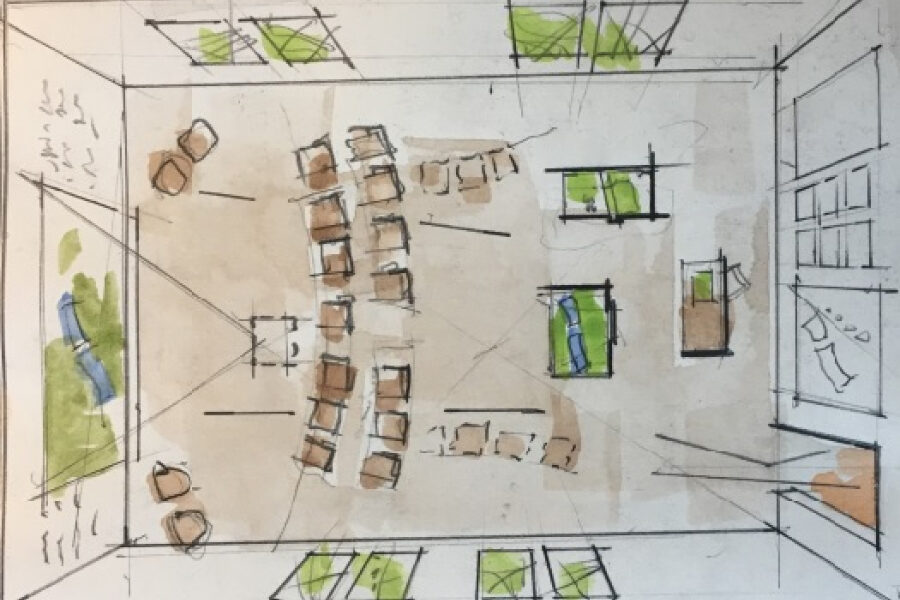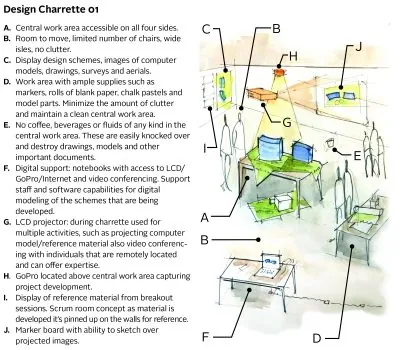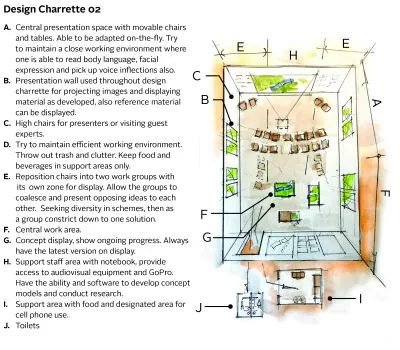The Dos and Don’ts of Design Charrettes

Design charrettes aren’t what they used to be – and for good reason.
The concept came together a few centuries ago in France, where architect professors would send a cart around to pick up work from the students.
If the students weren’t done, they would jump in the cart or run alongside it with their work to continue tweaking until it was time to present.
These days, design charrettes may look more like brainstorms, as a roomful of architects, engineers, contractors and clients hash out and contribute to a big idea. Modern charrettes are collaborative and problem seeking, pushing creative boundaries while keeping client leaders engaged and prepared to defend whatever may come out of the studio.
If you’re going to host a design charrette for your next big project, be prepared with these guidelines.
Start With Goals and a Plan, Not a Destination
If you are forming a charrette with a preconceived idea in mind, don’t bother. Charrettes will only be successful without hidden agendas and predetermined destinations. Instead, when planning a charrette with your team and a client:
- Define goals that are obtainable and yet demanding, so that expectations can be managed.
- Build out a schedule that factors in breaks and keeps a demanding pace.
- Try to find a location on the project site, which will get everyone off their home turf.
- Strive for diversity in authority, culture, gender and expertise, and know the personalities and group dynamics before you meet if possible.
Create an Environment of Consistent Participation
Now that you have a design charrette on the calendar, it’s time to develop ground rules for participants and for yourself. You must treat the charrette as the most important day (or days) of your project work lifecycle. The challenge to the facilitator is to amplify the magnitude and diversity of ideas, and then build up the best solution.
- Outline the expertise of – and expected contribution for – everyone in the room.
- Keep the meeting on track with one voice, disallowing multiple sidebar conversations at once, which can derail progress.
- Designate a space outside the room for phone calls, and set clear guidelines for cell phone use in the charrette environment.
- Know your subject and study all materials you can beforehand. Know the terms, processes, project challenges and constraints.
- Set up a parking lot board where ideas that may sidetrack the current effort can be captured and then returned to if time allows.
- Develop presentations in native programs – such as SketchUp, Excel and Revit – so that changes can be made by your staff immediately.
Lean into Technologies for Virtual Design Charrettes
In a time when many work from home, virtual design charrettes can be beneficial in keeping collaborative conversations moving ahead. To host a successful virtual design charrette:
- Have a team of three lead the virtual charrette. Have a subject matter expert (SME), a moderator who keeps the call moving forward and a software expert who can make changes and renders to any virtual forms via computer modeling.
- Use a camera mounted high over your desk so you can show planning documents and sketches throughout the charrette.
- Utilize programs like SketchUp that integrate with video conferencing software so the team can sketch a facility in real-time.
Hold On Loosely and Don’t Let Go
We often think of creativity as an epiphany or moment. In reality, creativity is hard work. The group needs discipline, focus and harmonic convergence to flesh out the big idea. The goal is for everyone to leave the room with that singular idea, rich with visuals and easy to comprehend.
How much time will that take? To answer this question is to understand the correlation between time and ideas during a charrette.
As time goes on, all the ideas the team had upon entering the charrette are spent. That’s when the dead air comes in, which leads to a whole new wave of ideas and criteria that start manifesting. To get to this point:
- In complex organizations, you want to comb up to the surface any underlying angst about the project and solve it in the room. Don’t resort to email chains and telephone tag after the charrette is over.
- Benchmark your client’s competition and dig into ways this project can be better.
- Keep the charrette moving and do not let it languish; more importantly, keep your charrette team, goals and vision intact. Once the teammates, goals and vision change, the only move left is to start the entire process over.
- After you send the client home for the night, your team’s work begins in earnest. Keep working on the pieces through the night, making any necessary revisions until the vision matures and has clarity.
- Represent this refined scheme back to the full client team on the second day.
Once you have your big idea, you can make your case with all your reasons and all of your boards filled with supporting evidence. Everything the group has come up with goes into the design book. Because everyone was involved in the finished product, everyone can explain and defend it.
And, because everyone at this point agrees with what everyone has come up with, the approval process is fast. Everyone is united, and they can go back to their teams and serve as your project’s greatest promoters.
This harmony may be the greatest result of any design charrette. The path may be long and filled with egos and disagreements, but true innovation awaits those who can stay on it.
This article was originally published on March 13, 2018, and updated on April 11, 2023.






